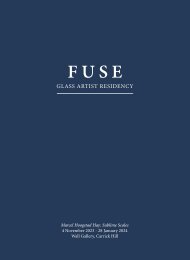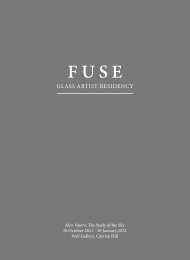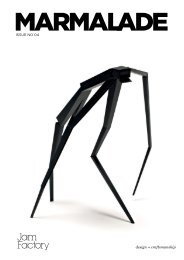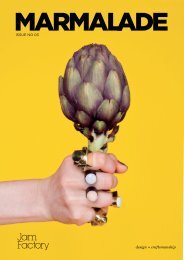Marmalade Issue 5, 2017
You also want an ePaper? Increase the reach of your titles
YUMPU automatically turns print PDFs into web optimized ePapers that Google loves.
To mark the 40th Anniversary of the ATW in 2016 and<br />
enable this expertise to be passed on to a new generation of<br />
tapestry weavers, the organisation initiated a trainee weaver<br />
program that incorporated key elements of the original,<br />
refined through reference to the Associate Training Program<br />
developed by JamFactory. While tapestry weaving is the<br />
sole focus of the ATW and JamFactory offers training in<br />
four disciplines – ceramics, glass, furniture and metal design<br />
– the organisations have many similarities. Both provide<br />
opportunities for advanced skills development, mentorship<br />
by expert and experienced practitioners, and access to<br />
specialised knowledge and skills through collaborative work.<br />
Noting the benefits of JamFactory’s two-year Associate<br />
program and the opportunities for peer learning enabled<br />
by recruiting small groups rather than single trainees, the<br />
ATW decided to offer a two-year traineeship program to<br />
three trainee weavers. Funding was generously provided by<br />
donors contributing to the ATW Annual Appeal through the<br />
Tapestry Foundation of Australia and the Pratt Foundation.<br />
These funds were used to support a comprehensive<br />
program focused on developing each trainee’s technical and<br />
interpretive skills as well as their personal visual and woven<br />
language, together with their capacity to work collaboratively<br />
and learn the allied professional skills necessary to work as a<br />
production tapestry weaver.<br />
As opportunities to learn tapestry weaving in Australia are<br />
limited, especially with the contraction of specialist textile<br />
courses in higher education, applicants otherwise eminently<br />
suited for the trainee program could not be expected to<br />
have tapestry weaving skills. So a two-stage recruitment<br />
process was devised where the first stage focused on<br />
recruiting ‘highly motivated, enthusiastic visual arts or design<br />
graduates, with a ‘can-do’ attitude who wish to make a<br />
career in tapestry weaving’. Shortlisted applicants were then<br />
offered a five-day intensive workshop in tapestry weaving<br />
with Joy Smith, an experienced workshop weaver with her<br />
own professional practice, in order to gauge their enthusiasm<br />
and aptitude for the process. The workshop took place in the<br />
ATW premises in South Melbourne so participants could see<br />
the studio at work, engage in discussion with the weaving<br />
team and get a ‘feel’ for working collaboratively in such a<br />
specialised environment.<br />
The ATW was gratified and not a little surprised at the<br />
number and quality of applicants for the trainee positions.<br />
Eighty-one applications were received from Australasia and<br />
12 from applicants based in Europe, America and Asia. They<br />
came from a wide ranges of disciplines in the visual arts and<br />
design, most with a particular interest in textiles. Quite a few<br />
had postgraduate as well as undergraduate qualifications, an<br />
indication perhaps of the lack of employment opportunities<br />
for visual arts graduates, as well as the attraction of working<br />
in an organisation focused on making artworks like the<br />
ATW. Due to the generally high quality of the applications it<br />
was not easy to select 13 to attend the workshop and from<br />
these candidates, five for the final interview, but finally three<br />
trainees were selected to begin their traineeships in late 2016.<br />
Karlie Hawking, Leith Maguire and Sophie Moorhouse Morris<br />
took up their trainee positions with an already impressive<br />
range of creative making and drawing skills, experience as<br />
artists and museum professionals, and a passion for working<br />
with communities. Each brought with them huge enthusiasm<br />
for the medium of tapestry and collaborative work. They<br />
are (at the time of publication) 11 months into their two-year<br />
training program which provides technical and interpretive<br />
tapestry skill development and the experience of working<br />
collaboratively, as well as learning the skills required to<br />
conserve tapestries and cost tapestry production. They<br />
also participate in the daily life of the workshop; engage<br />
with artists in residence, attend specialist weaving classes,<br />
give presentations and visit art exhibitions. To give them<br />
an international perspective on the running of a tapestry<br />
workshop and to enhance their historical knowledge, in<br />
late <strong>2017</strong> the trainees will participate in a weaver exchange<br />
program with the Dovecot in Scotland and join Cresside<br />
Collette’s tour of historical tapestries in France.<br />
A key aspect of their education is provided by opportunities<br />
to observe the weaving team engaging with artists as they<br />
develop the interpretation of an artwork, to see how they<br />
set the parameters for each commission through weaving<br />
samples, deciding on the warp sett and approach, and how<br />
they monitor the progress of each tapestry to bring out<br />
artist’s vision, and finish on time and within budget. While<br />
the basic skills of tapestry weaving can be taught within a<br />
week, it can take years to develop the seemingly effortless<br />
fluency that characterises ATW tapestries and even longer to<br />
become a proficient production weaver able to create work<br />
of the highest quality within the constraints of time<br />
and money.<br />
When asked to nominate the most rewarding part of the<br />
training program to date the trainees unanimously identified<br />
the opportunity to learn from deeply experienced weavers<br />
and artists and to work collaboratively, especially with one<br />
another. As Hawking observed, ‘to be able to chat with<br />
Sophie and Leith and share so many ideas… we’re better<br />
as a team than as individuals’. Being able to spend every<br />
day exploring the creative possibilities of the medium has<br />
fast-tracked their weaving expertise. Moorhouse Morris<br />
noted with some surprise that ‘it’s amazing to be weaving all<br />
day, every day, it’s why we’ve progressed so quickly, being<br />
completely immersed in the process’. When reflecting on<br />
their first experience of sitting at the large loom weaving the<br />
hem of a commissioned work, Maguire commented, ‘It’s a<br />
different kind of experience to sit in a line weaving together,<br />
talking about what we’re doing. The physical and mental<br />
stimulus is something I’ve never experienced in the same way<br />
in my own practice… here we’re all working towards the same<br />
goal’. It’s this passion and sense of shared purpose that has<br />
underpinned the longevity of the ATW and the quality of the<br />
tapestries produced in its 40-year history. This new group<br />
of trainees is well positioned to take this ethos and expertise<br />
into the future.<br />
Previous page: Trainees in the workshop.<br />
Top right: Australian Tapestry Workshop, Melbourne.<br />
Right: Weave sample by Sophie Morris.<br />
All photos courtesy of the Australian Tapestry Workshop.<br />
46 / ISSUE 05











